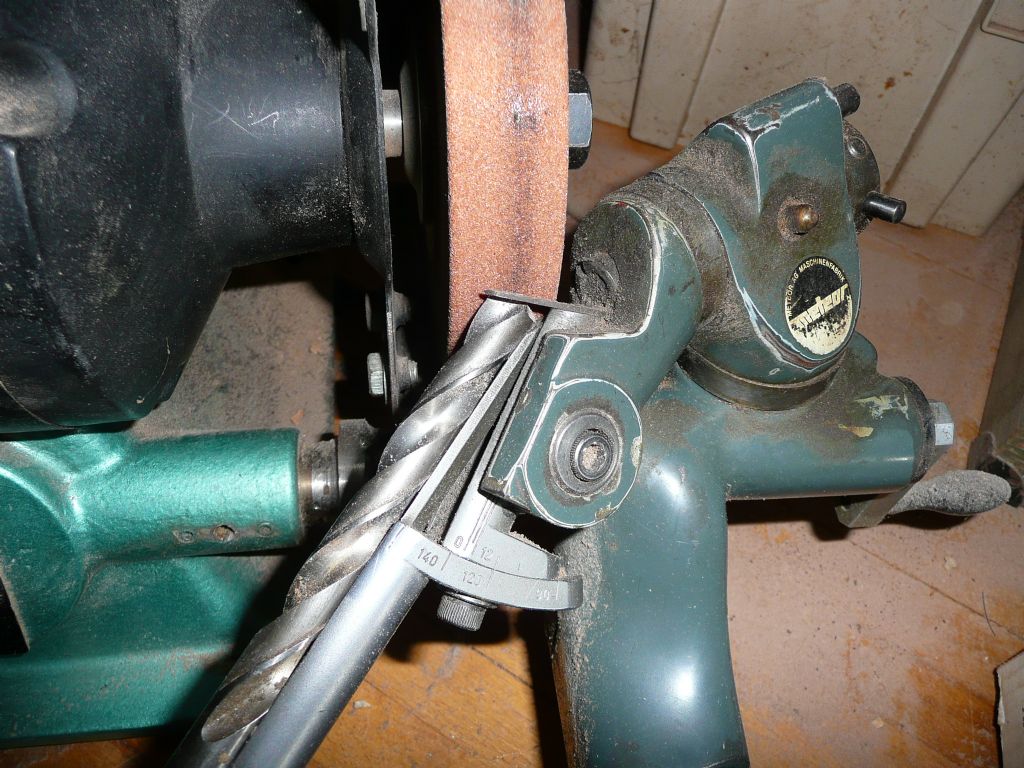I came across this thread a few weeks ago and whilst I did not study it in detail soon became aware that sharpening drills was not for most an easy task. This not only with the common economy jig used with the off hand grinder, but also with the much more expensive Proxxon, both of which I have and have had similar findings.
I have though largely mastered the basic jig but as my comments below show I still have some way to go with the Proxxon, if I ever do.
The subtle difference between the Proxxon and the basic jig is that the pivot on the Proxxon is fixed relative to the grinding wheel and the projection of the drill is therefore also fixed. With the basic jig, backing off is controlled by the amount the drill projects. Therefore, after a few drills have been sharpened and the required projections taken note of, interpolating values for other diameters will be very easy and easily measured, there being no need to rotate the drill for differing diameters as is required with the Proxxon.
First, I have to agree that the instructions for both are far from adequate, even though those for the Proxxon would appear to be very detailed. No doubt this is a major factor in the problem the users have. I do not want to sound superior, but I feel a major factor is also that many users do not have sufficient background knowledge to overcome the limitations in the instructions.
When I read the thread I decided to attempt to be of help by adding to my website the basics from my article in MEW relating to drills and drill sharpening. This I have now done and can be found at
http://www.homews.co.uk/page354.html
Hope this helps
As I was going to add to the thread I decided to get out the Proxxon and give it another try. The drill is first fitted with a device that enables it to be accurately rotated 180 degrees between edges and is first set using a cradle for the purpose. The mad thing though is that, this setting is only applicable to a drill in the middle of the range being 8mm diameter, probably, say, between 7 and 9mm. For smaller drills the setting has immediately to be re set by rotating the drill clockwise which can only be done hand held and visually.
Measuring the angle required off the very small sketch in the manual, the angle is 28 degrees for a 3mm drill. For other sizes it is obviously a case of interpolating the required values, typically 14 degrees for 5.5mm drill. For drills larger than 8mm then the drill is rotated anticlockwise again 28 degrees for a 13mm drill. As there is no method of setting these values then they can only be set visually, of course precision is not require.
I decided to carry out a test on an almost new SKF 10mm drill and first drilled a hole, without pilot, into a piece of mild steel and took note of the pressure required.
Next, I set the drills cutting edge vertically, (as I would for the basic jig) first stage above only, and sharpened it. Visually. it did look sharp but the chisel angle looked a little on the small side, rather less than 130 degrees, as did the backing off behind the cutting edges. I again tested it in the mild steel and whilst it did drill it needed very much more force to feed the drill and was obviously not usable.
I then rotated the drill, as indicated above, and resharpened it. This time the chisel angle was far to great and had to call a halt as time had run out. Obviously, the initial rotational angle of the drill in its holder is quite important and as this can only be set visually I have reservations regarding the device.
I will though, when time allows, carry out some more test, perhaps I can come up with some way of setting the angle, other than visually. I do wonder that, as no actual values for the rotation are given, has the draughtsman taken licence and exaggerated the angles to make them more visible, maybe the 28 degrees is not correct.
Siddley.




 On the other hand, mine still seem to be working.
On the other hand, mine still seem to be working.
 )
)

